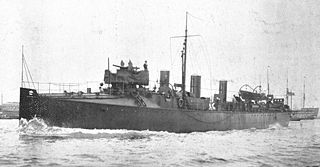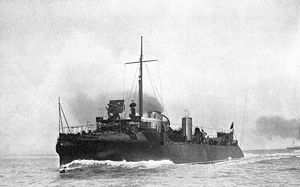
The Havock class was a class of torpedo boat destroyer (TBD) of the British Royal Navy. The two ships, Havock and Hornet, built in London in 1893 by Yarrow & Company, were the first TBDs to be completed for the Royal Navy, although the equivalent pair from J.I. Thornycroft, Daring and Decoy, were ordered five days earlier.

The River-class destroyer was a class of torpedo boat destroyer built for the Royal Navy at the turn of the 20th century, and which saw extensive service in World War I. The class introduced new features to destroyer design, placing a greater emphasis on seakeeping and endurance and less on a high maximum speed in good weather. All the ships were named after British and Irish rivers, and as such were the first Royal Navy destroyer class to be named systematically.

The D class as they were known from 1913 was a fairly homogeneous group of torpedo boat destroyers (TBDs) built for the Royal Navy in the mid-1890s. They were all constructed to the individual designs of their builder, John I. Thornycroft & Company of Chiswick, to meet Admiralty specifications. The uniting feature of the class was a top speed of 30 knots and they all had two funnels.

The B class as designated in 1913 was a heterogeneous group of torpedo boat destroyers (TBDs) built for the Royal Navy in the late 1890s. They were constructed to the individual designs of their builders to meet Admiralty specifications, the uniting feature being a specified top speed of 30 knots (56 km/h) and four funnels, although the funnel spacings differed between ships. All "30 knotter" vessels with four funnels were classified by the Admiralty as the B class in 1913 to provide some system to the naming of HM destroyers. At the same time all "30 knotter" vessels with three funnels were classified by the Admiralty as the C class and those with two funnels became the D class.

HMS Hornet was a Havock-class torpedo boat destroyer of the British Royal Navy. She was launched in 1893 and sold in 1909 for scrapping. Although the Daring-class torpedo boat destroyers were ordered first, Havock and Hornet were completed faster, making them the first destroyers ever built.

Two Daring-class destroyers were the very first torpedo boat destroyers ("TBDs") to be ordered for the Royal Navy, the order being placed on 27 June 1892.

The three Ardent-class torpedo boat destroyers were ordered by the British Admiralty on 12 October 1893 and served with the Royal Navy. Built by Thornycroft for a contract price of £110,520 for all three vessels, they displaced 301 tons fully laden, and were 201 feet 8 inches (61.47 m) long overall.

HMS Ardent was a Royal Navy 27 knot torpedo boat destroyer ordered from John I Thornycroft & Company under the 1893 – 1894 Naval Estimates. She was the sixth ship to carry this name.
HMS Boxer was an Ardent-class destroyer which served with the Royal Navy, launched on 28 November 1894. She spent several years operating with the Mediterranean Fleet and remained active during the First World War. She was sunk in a collision on 8 February 1918.

HMS Bruizer was an Ardent-class destroyer which served with the Royal Navy. She was launched on 27 February 1895 by John Thornycroft at Chiswick, and was sold on 26 May 1914.

The three Charger-class destroyers were all ordered by the British Admiralty on 12 October 1893 and on completion in early 1896 they served with the Royal Navy until 1911.

HMS Charger was a Charger-class destroyer which served with the Royal Navy. She was launched by Yarrow Shipbuilders at Poplar, London on 15 September 1894, served in home waters and was sold off in 1912.

HMS Dasher was a Charger-class destroyer which served with the Royal Navy. She was built by Yarrow Shipbuilders in 1895, served in home waters and was sold in 1911.
HMS Haughty was a Hardy-class destroyer which served with the Royal Navy. She was launched by William Doxford & Sons on 18 September 1895, served in home waters, and was sold on 10 April 1912.
The Salmon class were two destroyers built by Earle's to an Admiralty specification for service with the Royal Navy.
Two Swordfish-class destroyers served with the Royal Navy. Swordfish and Spitfire were both built by Armstrong Whitworth at Elswick, Tyne and Wear launching in 1895. Fitted with Yarrow boilers, they could make 27 knots and were armed with one twelve pounder and two torpedo tubes.

The Sunfish-class destroyers, also referred to as Opossum-class destroyers, was a group of three torpedo boat destroyers which served with the Royal Navy from the 1890s to the 1920s. They were all built by the Hebburn-on-Tyne shipyard of Hawthorn Leslie.

HMS Sunfish was a "twenty-seven knotter" torpedo boat destroyer of the British Royal Navy. Built by the Tyneside shipbuilder Hawthorn Leslie, Sunfish was one of three destroyers built by Hawthorns that year. She was sold for scrap in 1920.












